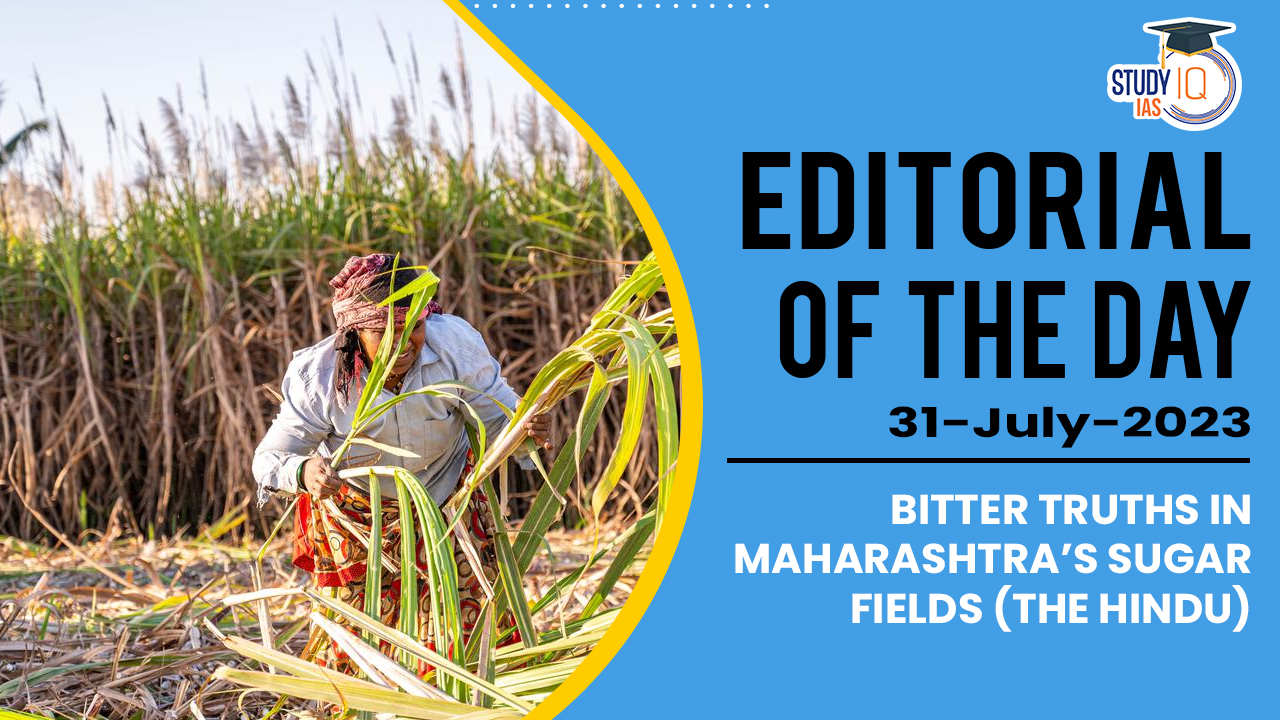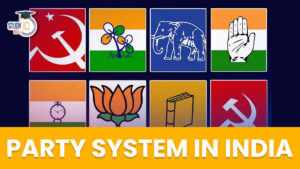Table of Contents
Context: The article is discussing the exploitation and vulnerability of intra-State migrant workers who migrate seasonally from the drought-affected and water-scarce regions of Marathwada in Maharashtra to work in the sugar-belt region of western Maharashtra. These migrant workers play a crucial role in the sugar cane industry and economic growth of the state, but they have remained marginalised and oppressed for several decades. The article highlights suo motu cognizance that the Bombay High Court has taken asking the Maharashtra government to form a committee to address the issues faced by these migrant workers. The article emphasizes the need for long-term and comprehensive policies to address the vulnerability of these migrant workers both at the source and destination regions. It calls for the creation of a favourable legal environment to protect the rights and safety of seasonal migrant workers in the sugar industry in Maharashtra.
Background
Who is a Migrant Worker?
- A migrant worker is a person who migrates within a home country or outside it to pursue work.
- Migrant workers usually do not have the intention to stay permanently in the country or region in which they work.
- In India, Migrant workers usually refer to those who engage in internal migration within the country, often for the purpose of seeking employment.
- Internal migration refers to the movement of people from one place to another within the same country.
Internal Migration in India:
- As per census 2011, the total number of internal migrants in India is 36 crore or 37% of the country’s population.
- The Economic Survey pegged the size of the migrant workforce at roughly 20 per cent or over 10 crore in 2016.
- Major origin states of internal migration: Uttar Pradesh, Bihar, Rajasthan, Madhya Pradesh, Jharkhand, and Odisha.
- Major destination states of internal migration: Maharashtra, Delhi, Gujarat, Tamil Nadu, Karnataka, and Punjab.
- Sectoral composition: The share of migrant workers is the highest in the construction sector for females while the highest number of male migrant workers are employed in public services (transport, postal, public administration services) and modern services (financial intermediation, real estate, renting, education, health).
Problems Faced by Migrant Workers in India:
- Lack of job security: Migrant workers often work in unorganised and informal sectors with low wages and no job security. They are vulnerable to exploitation, including being paid less than minimum wages, being forced to work long hours, and being subjected to unsafe working conditions.
- Social exclusion: Migrant workers are often stigmatized and discriminated against due to their ethnicity, language, and cultural differences.
- Lack of legal protection: They often face difficulties in accessing justice when their rights are violated. They are not covered by most labour laws and do not have access to social security benefits.
- Inadequate living conditions: Migrant workers often live in crowded and unhygienic living conditions, with limited access to sanitation facilities. This makes them vulnerable to diseases and illnesses.
- Lack of access to education: Migrant children often face challenges in accessing education due to language barriers and discrimination. Many of them drop out of school to support their families.
- Exploitation by middlemen: Migrant workers often rely on middlemen or labour contractors to find work, who take advantage of their vulnerable position by charging high fees and forcing them to work in unsafe and exploitative conditions.
- Lack of coordination among states: There is inadequate coordination among states on a formal exchange of information on migrant workers. In the absence of data, it is difficult to track labourers during times of crisis.
Decoding the Editorial
The article is discussing the exploitation and vulnerability of intra-State migrant workers in Maharashtra.
Plight of Migrant workers:
- The workers’ precarious situation is caused by prolonged drought conditions, repeated crop failure, debt, and acute unemployment in their home regions, which force them to migrate in search of work.
- The prevailing exploitative structure of recruiting migrant workers in the sugar cane industry continues through the ‘Mukadam’ (labour contractor) system.
- The Mukadam system supplies temporary, cheap, and efficient labour to sugar factories, but it also results in workers’ dependency, violation of labour laws, and lack of a proper relationship between the factory and the workers.
- The Mukadam has a contract with sugar factories to supply ‘Koytas’ (labour couples) and takes an advance to pay workers.
- Because of eco-political reasons, the Mukadam system remains the focal point; migrant workers are very dependent on the Mukadam.
- Consequently, it creates adequate space to control migrant workers, violates labour laws, and is unfavourable to establish any relationship between the factory and workers.
Gaps in the data, plight of women, children:
- Lack of Data and Policies: Inadequate data on seasonal migrants, particularly women migrants and children, is a significant challenge in formulating effective policies for their well-being. There is a need for a comprehensive and credible databank of seasonal migrants to address their specific needs.
- Migration Tracking System (MTS): The Maharashtra government launched a technology-aided Migration Tracking System (MTS) in 2022 to enumerate and track seasonal migrants, especially children, pregnant women, and lactating mothers in tribal districts. The MTS aimed to ensure nutrition, immunization, and early childhood care through the Integrated Child Development Services.
- Incomplete Picture of Migrants: Despite the MTS, the current scope does not provide a comprehensive picture of seasonally migrating families, including their employment status, wage structure, and entitlement coverage. There is a need to expand the MTS to cover the sugar belt and other seasonal migration corridors to better understand the dynamics and address specific needs.
- Education of Migrant Children: Children who accompany their parents to work in the sugar cane fields face violations of their right to education. The lack of sufficient alternative schooling models leads to many of these children possibly being forced into child labour. Even though these children are physically absent from school, their absence is not always acknowledged in school records.
- Though the National Education Policy (NEP) 2020 emphasises equitable and inclusive education for all, the Right to Education of children who accompany their parents to sugar cane fields is violated blatantly.
- There are no sufficient alternative schooling models, which in turn affect their education. They are probably forced into child labour.
- In their joint study, the International Institute for Population Sciences (IIPS) and UNICEF (2022) observed that despite these children being physically absent from school, school records do not acknowledge this in many cases.
Way Forward
- Need for Government Intervention: Seasonal migrants are facing challenges in accessing justice and ensuring safe and healthy working and living conditions. There is a need for government intervention to address these issues and protect the rights of migrant workers.
- Collaboration Among Ministries and Departments: The State government should collaborate with different Ministries and Departments to formulate targeted and time-bounded interventions for the benefit of seasonal migrants. Working together can lead to more effective and comprehensive solutions.
- Political Will for a Favourable Legal Environment: It is emphasized that strong political will is required to create a favourable legal environment that protects the rights of migrants. This may involve strengthening labour administration and implementing policies that safeguard the interests of migrant workers.
- Disparity in Vision and Neglect of Migrants: There is a contradiction between the vision of an empowered and inclusive economy and the neglect faced by seasonal migrants. Despite the State’s humanitarian obligations, large groups of migrant workers are often left helpless and in jeopardy due to lack of attention and action from State functionaries.
- Call for Specific Action: There is a call for specific action to address the challenges faced by seasonal migrants. It urges authorities to stop neglecting the plight of migrant workers and take concrete steps to protect their rights and well-being.
Beyond the Editorial
Legal Framework for Migrant Welfare in India:
The Inter-State Migrant Workmen Act, 1979 looks into the welfare of the labourers.
Key provisions of the act:
- The Act mandates that the establishment which proposes to employ migrant workers be required to be registered with destination states.
- Contractors will also have to obtain a licence from the concerned authority of the home states as well as the host states.
Issues with the Act:
In practice, this Act has not been fully implemented.
- This Act has been subsumed into the four broad labour codes notified by the Centre: The Code on Wages, 2019; The Industrial Relations Code, 2020; The Code on Social Security, 2020; and The Occupational Safety, Health and Working Conditions Code, 2020.
- These have not been implemented yet.
States which have tried implementing the Act:
- Andhra Pradesh and Odisha: In 2012, with the help of the International Labour Organisation, a MoU was signed between Odisha and Andhra Pradesh to track labourers migrating from 11 districts of Odisha to work in brick kilns in then-united Andhra Pradesh.
- Kerala: Kerala has set up facilitation centres for migrant workers whom the state refers to as “guest workers”. These facilitation centres maintain data regarding migrant workers arriving in Kerala as well as help migrant workers navigate any problems they might face.
Government Initiatives for the Welfare of Migrant Workers:
- Pradhan Mantri Garib Kalyan Yojana: After the lockdown, Pradhan Mantri Garib Kalyan Yojana with a financial package of Rs. 1.7 lakh crore was launched to help poor, needy and unorganised sector workers of the country.
- PM SVANidhi Scheme: The Scheme was launched to facilitate collateral free working capital loan up to Rs.10,000/- of one-year tenure, to approximately 50 lakh street vendors, to resume their businesses.
- Pradhan Mantri Garib Kalyan Rojgar Abhiyan: In order to facilitate employment of migrant workers who have gone back to their home state, Pradhan Mantri Garib Kalyan Rojgar Abhiyan was initiated in 116 districts in Mission Mode.
- State migrant cell: Migrant workers’ Cell is being created to prepare a database of migrant workers in states with mapping.
- eShram portal: It is a national database created to register the unorganized workers in the country, including the migrant workers.
- National policy on migrant workers: NITI Aayog has been mandated to prepare a draft national policy on migrant workers to reimagine labour-capital relations while integrating the migrant workers within the formal workforce.


 Custodial Deaths in India, Types, Issues...
Custodial Deaths in India, Types, Issues...
 MPPSC FSO Recruitment Notification 2025 ...
MPPSC FSO Recruitment Notification 2025 ...
 Party System in India, Feature, Importan...
Party System in India, Feature, Importan...





















